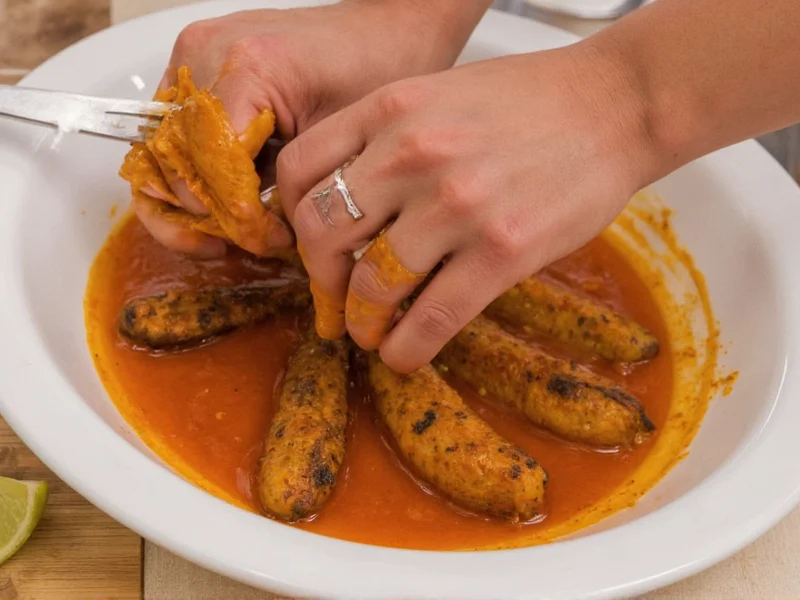When you handle spicy peppers like jalapeños or habaneros, the burning sensation that lingers on your hands comes from capsaicin, an oil-based compound that doesn't wash away with water alone. Understanding how to effectively remove this stubborn substance can save you from hours of discomfort. This guide provides scientifically-backed methods that actually work, not just kitchen folklore.
Why Water Alone Doesn't Work for Spicy Hands
Capsaicin, the chemical responsible for the heat in chili peppers, is hydrophobic—meaning it repels water. When you wash spicy residue off hands with just water, you're essentially trying to wash oil with more oil. The capsaicin molecules bind to the nerve receptors in your skin, triggering that familiar burning sensation that can last for hours if not properly treated.
5 Proven Methods to Remove Spicy Residue from Hands
These approaches work by either dissolving the capsaicin oil, neutralizing its effects, or creating a barrier between the compound and your skin receptors.
| Method | How It Works | Effectiveness | Time Required |
|---|---|---|---|
| Soap and Oil Combination | Dissolves capsaicin oil | ★★★★★ | 2-3 minutes |
| Vinegar or Lemon Juice | Neutralizes alkaline capsaicin | ★★★★☆ | 3-5 minutes |
| Dairy Products | Binds to capsaicin molecules | ★★★☆☆ | 5-10 minutes |
| Baking Soda Paste | Gentle abrasive action | ★★★☆☆ | 5 minutes |
| Rubbing Alcohol | Dissolves oil-based compounds | ★★★★☆ | 2-3 minutes |
Detailed Step-by-Step Removal Techniques
1. The Soap and Oil Method (Most Effective)
This approach works because "like dissolves like"—oil dissolves oil. Capsaicin is oil-based, so you need another oil to break it down before washing.
- Apply a small amount of vegetable oil, olive oil, or even peanut butter to your hands
- Gently rub the oil into affected areas for 30-60 seconds
- Add dish soap (which contains surfactants that break down oils)
- Wash thoroughly with warm water for at least 20 seconds
- Dry hands completely
Repeat if necessary. This method effectively removes capsaicin from hands by first dissolving the oil-based compound before washing it away.
2. Acidic Solutions: Vinegar or Lemon Juice
Capsaicin is slightly alkaline, so acidic solutions can help neutralize it. White vinegar (5% acetic acid) or fresh lemon juice both work well.
- Mix equal parts vinegar and water in a bowl
- Soak hands for 3-5 minutes (use lemon juice undiluted)
- Rinse with cool water
- Follow with soap and water wash
This approach to get spicy off hands works particularly well for immediate relief when you don't have oils available.
3. Dairy-Based Relief
Milk contains casein, a protein that binds to capsaicin and helps wash it away from skin receptors.
- Soak a paper towel in cold whole milk or buttermilk
- Apply to affected areas for 5-10 minutes
- Rinse with cool water
- Wash with soap and water
Yogurt works similarly—apply plain yogurt to hands, wait 5 minutes, then rinse. This method to stop hands burning after handling jalapenos provides soothing relief while removing the capsaicin.
4. Baking Soda Paste
Baking soda creates a mild abrasive paste that helps lift capsaicin from the skin's surface.
- Mix 2 tablespoons baking soda with enough water to form a paste
- Gently rub onto hands for 2-3 minutes
- Rinse thoroughly with cool water
- Follow with moisturizer (baking soda can be drying)
This technique for how to get capsaicin off hands works well for stubborn residue but may require multiple applications.
5. Rubbing Alcohol Solution
Isopropyl alcohol dissolves oil-based compounds like capsaicin effectively.
- Apply 70% isopropyl alcohol to a cotton ball
- Gently wipe affected areas
- Rinse with cool water after 1-2 minutes
- Moisturize thoroughly (alcohol is drying)
This quick method to remove chili burn from skin works in minutes but should be followed by moisturizing to prevent skin irritation.
What NOT to Do When Your Hands Burn from Peppers
Avoid these common mistakes that can worsen the situation:
- Don't use hot water—it opens pores and can intensify the burning
- Avoid touching your face or eyes—this transfers capsaicin to sensitive areas
- Don't rub vigorously with a towel—this spreads the oil and irritates skin
- Avoid petroleum jelly alone—it traps capsaicin against your skin
Preventing Spicy Hand Burns During Food Preparation
The best approach for how to stop hands burning after handling peppers is prevention:
- Wear disposable nitrile gloves (latex isn't sufficient as capsaicin can penetrate)
- Apply a thin layer of cooking oil to hands before handling peppers
- Use a dedicated cutting board for spicy ingredients
- Wash hands immediately after handling peppers using the oil-and-soap method
- Keep vinegar or dairy products nearby when working with extremely hot peppers
When to Seek Medical Attention
While capsaicin burns are usually temporary, consult a healthcare provider if you experience:
- Severe blistering or skin damage
- Prolonged burning lasting more than 24 hours
- Signs of infection (increased redness, swelling, pus)
- Accidental contact with eyes or other sensitive membranes











 浙公网安备
33010002000092号
浙公网安备
33010002000092号 浙B2-20120091-4
浙B2-20120091-4